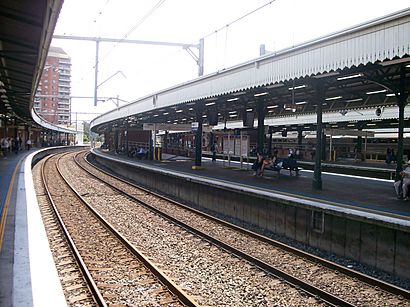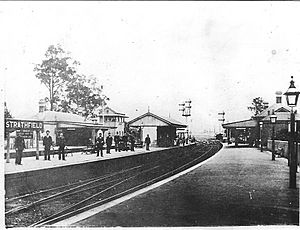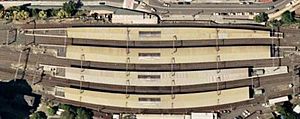Strathfield railway station facts for kids
Quick facts for kids
Strathfield
|
|||||||||||||||||||||||||||||||||||||||||||||||||||||||||||||
|---|---|---|---|---|---|---|---|---|---|---|---|---|---|---|---|---|---|---|---|---|---|---|---|---|---|---|---|---|---|---|---|---|---|---|---|---|---|---|---|---|---|---|---|---|---|---|---|---|---|---|---|---|---|---|---|---|---|---|---|---|---|

Westbound view from Platform 7
|
|||||||||||||||||||||||||||||||||||||||||||||||||||||||||||||
| Location | Albert Road, Strathfield, New South Wales Australia |
||||||||||||||||||||||||||||||||||||||||||||||||||||||||||||
| Coordinates | 33°52′18″S 151°05′40″E / 33.87180°S 151.09433°E | ||||||||||||||||||||||||||||||||||||||||||||||||||||||||||||
| Owned by | Transport Asset Holding Entity | ||||||||||||||||||||||||||||||||||||||||||||||||||||||||||||
| Operated by | Sydney Trains | ||||||||||||||||||||||||||||||||||||||||||||||||||||||||||||
| Line(s) | Main Suburban | ||||||||||||||||||||||||||||||||||||||||||||||||||||||||||||
| Distance | 11.81 km (7.34 mi) from Central | ||||||||||||||||||||||||||||||||||||||||||||||||||||||||||||
| Platforms | 8 (4 island) | ||||||||||||||||||||||||||||||||||||||||||||||||||||||||||||
| Tracks | 8 | ||||||||||||||||||||||||||||||||||||||||||||||||||||||||||||
| Connections | Bus | ||||||||||||||||||||||||||||||||||||||||||||||||||||||||||||
| Construction | |||||||||||||||||||||||||||||||||||||||||||||||||||||||||||||
| Structure type | Ground | ||||||||||||||||||||||||||||||||||||||||||||||||||||||||||||
| Disabled access | Yes | ||||||||||||||||||||||||||||||||||||||||||||||||||||||||||||
| Other information | |||||||||||||||||||||||||||||||||||||||||||||||||||||||||||||
| Status | Staffed | ||||||||||||||||||||||||||||||||||||||||||||||||||||||||||||
| Station code | STR | ||||||||||||||||||||||||||||||||||||||||||||||||||||||||||||
| Website | Transport for NSW | ||||||||||||||||||||||||||||||||||||||||||||||||||||||||||||
| History | |||||||||||||||||||||||||||||||||||||||||||||||||||||||||||||
| Opened | 9 July 1876 | ||||||||||||||||||||||||||||||||||||||||||||||||||||||||||||
| Electrified | Yes | ||||||||||||||||||||||||||||||||||||||||||||||||||||||||||||
| Traffic | |||||||||||||||||||||||||||||||||||||||||||||||||||||||||||||
| Passengers (2018) | 49,910 (daily) (Sydney Trains, NSW TrainLink) | ||||||||||||||||||||||||||||||||||||||||||||||||||||||||||||
| Rank | 11 | ||||||||||||||||||||||||||||||||||||||||||||||||||||||||||||
| Services | |||||||||||||||||||||||||||||||||||||||||||||||||||||||||||||
|
|||||||||||||||||||||||||||||||||||||||||||||||||||||||||||||
| Official name |
|
||||||||||||||||||||||||||||||||||||||||||||||||||||||||||||
| Type | State heritage (complex / group) | ||||||||||||||||||||||||||||||||||||||||||||||||||||||||||||
| Designated | 2 April 1999 | ||||||||||||||||||||||||||||||||||||||||||||||||||||||||||||
| Reference no. | 1252 | ||||||||||||||||||||||||||||||||||||||||||||||||||||||||||||
| Type | Railway Platform / Station | ||||||||||||||||||||||||||||||||||||||||||||||||||||||||||||
| Category | Transport - Rail | ||||||||||||||||||||||||||||||||||||||||||||||||||||||||||||
Strathfield railway station is a very important train station in Sydney, Australia. It's located in the suburb of Strathfield. This station is a major hub where different train lines meet. It serves local Sydney Trains services like the T1, T9, and T2 lines. It also connects to longer-distance NSW TrainLink trains.
Strathfield station is on the Main Northern and Main Western railway lines. This makes it a key meeting point for both local and regional train services. The station and its nearby railway structures are so important that they are listed on the New South Wales State Heritage Register. This means they are protected because of their historical value.
Contents
History of Strathfield Station
How Strathfield Suburb Got Its Name
The area around Strathfield was once known as Liberty Plains. This name came from the first free settlers who received land here. In 1808, James Wilshire got a large piece of land and called it Wilshire Farm.
Later, in 1824, a politician named Samuel Terry bought some land nearby. He named it Redmyre Estate, after a village in England. The name was changed to Redmyre around 1865.
In 1885, the area officially became a suburb called Strathfield. This new name came from a large house, or mansion, in the area called Strathfieldsaye. The mansion's owner, John Hardie, chose the name to honor a famous English estate given to the Duke of Wellington.
When Did Strathfield Get a Train Station?
The very first public railway line in New South Wales opened in 1855. It ran from Redfern to Parramatta, passing through the Strathfield area. However, there was no station at Strathfield at first. The closest stops were Burwood and Homebush.
The first station in Strathfield opened on 9 September 1876. It was called "Redmyre" then. On 8 March 1885, its name was changed to Strathfield. The station was named after the mansion Strathfield House.
Strathfield station became much more important when the Main Northern line was built. This new line branched off the Western line right at Strathfield. The first part of this line, going to Hornsby, opened on 17 September 1886.
Changes and Upgrades Over Time
When it first became a junction, Strathfield station had four platforms. Two were for the Western line and two for the Northern line. A new signal box was also built to control the train movements.
The station was rebuilt in 1900 and again in 1922. The 1922 rebuild created the station we mostly see today. It has four island platforms, which means there are eight platforms in total. Passengers can reach these platforms using a subway and ramps.
In 1927, the railway lines around Strathfield were electrified. This meant trains could run on electricity. As part of this upgrade, a new building was added to platform eight. It was first used for receiving coffins but later became a storage area for the station's refreshment room.
A new Power Signal Box was also built in 1927. This signal box was the third one at Strathfield. It controlled all train movements through the station and the tracks leading north and west. Strathfield became a crucial railway junction for all trains heading north and west from Sydney.
In 1982, a new, larger signal box complex was built at Homebush. This new system took over control from the Strathfield power signal box. Even today, the signalling for Strathfield is controlled from Homebush. It is the second largest signal box in the Sydney area.
What is the Strathfield Substation?
In 1927, when the train lines were electrified, the Strathfield Substation was built. This building helped convert electricity to power the trains. It started working on 27 August 1928. It was one of 15 such substations built in Sydney during that time.
Later, a newer substation replaced the original one. The old substation building was then used as a workshop for railway signalling equipment. It has been used by the Signal Branch since 1990.
How Train Routes Changed Over Time
Strathfield station grew into a major hub for local, intercity, and interstate trains. This made Strathfield a popular place for important people to live. For example, former Prime Minister Earle Page lived in Strathfield. He chose it because he could easily travel by train to Melbourne, where the federal parliament was located, and to his home area in northern New South Wales.
When the capital moved to Canberra, direct train services from Strathfield also went there. Other prime ministers, like George Reid and Frank Forde, also lived near Strathfield station.
However, in 2013, some changes happened. Intercity trains heading southwest to Canberra and Melbourne started using a different line, the East Hills line. This meant that only intercity trains going north and west continued to use Strathfield station.
Platforms and Services
| Platform | Line | Stopping pattern | Notes |
| 1 |
CCN
|
services to Central | |
|---|---|---|---|
|
North Coast Region
|
services to Central | ||
|
North Western Region
|
services to Central | ||
| services to Central, North Sydney & Hornsby via Gordon | occasionally used | ||
| services to Central, North Sydney & Gordon | occasionally used | ||
| 2 |
BMT
|
services to Central | |
|
T7
|
special event services to Central | ||
|
Western Region
|
services to Central | ||
| services to Hornsby & Berowra via Gordon | occasionally used | ||
| services to Central, North Sydney & Gordon | occasionally used | ||
| 3 |
BMT
|
services to Springwood, Katoomba, Mount Victoria & Lithgow | |
|
CCN
|
services to Newcastle | ||
|
T7
|
special event services to Olympic Park | ||
|
Western Region
|
services to Dubbo & Broken Hill | ||
|
North Western Region
|
services to Armidale/Moree | ||
|
North Coast Region
|
services to Grafton, Casino & Brisbane | ||
| services to Richmond & Emu Plains | occasionally used | ||
| services to Hornsby via Epping | occasionally used | ||
| 4 | services to Hornsby & Berowra via Gordon | ||
| services to Central & the City Circle | occasionally used | ||
| 5 | services to Gordon | ||
| 6 | services to Richmond & Emu Plains | ||
| services to Leppington & Parramatta | occasionally used | ||
| services to Hornsby via Epping | |||
|
Western Region
|
services to Dubbo & Broken Hill | occasionally used | |
|
North Western Region
|
services to Armidale/Moree | occasionally used | |
|
North Coast Region
|
services to Grafton, Casino & Brisbane | occasionally used | |
| 7 | services to Central & the City Circle | ||
| 8 | services to Homebush, Parramatta, Liverpool & Leppington |
How to Get Around: Transport Links
Strathfield station is a busy place for buses too! Several bus companies operate routes that stop at Strathfield station, connecting it to many other suburbs.
- Punchbowl Bus Company has one route:
- 450: To Hurstville
- Transdev NSW has three routes:
- 913: To Bankstown station
- 914: To Greenacre
- M90: From Burwood to Liverpool station
- State Transit has one route:
- 525: To Parramatta station via Olympic Park
- Transit Systems has seven routes:
- 407: To Burwood via Strathfield West
- 408: From Rookwood Cemetery to Burwood
- 415: From Campsie station to Chiswick
- 458: From Ryde to Burwood
- 480: To Central station
- 483: To Central station
- 526: From Burwood to Rhodes Shopping Centre
Strathfield station is also served by four NightRide bus routes. These are special bus services that run late at night when trains are not operating.
- N50: From Liverpool station to City (Town Hall)
- N60: From Fairfield station to City (Town Hall)
- N61: From Carlingford station to City (Town Hall)
- N80: From Hornsby station to City (Town Hall)
Why is Strathfield Station a Heritage Site?
Strathfield railway station is listed on the New South Wales State Heritage Register. This means it's considered very important to the history and culture of New South Wales.
The station complex includes several historic parts:
- The main station building and platforms, built in 1927.
- The platform awnings (roofs) from 1927.
- A brick building that used to be a signal box, also from 1927.
- A brick parcels room and platform.
- A pedestrian subway (underground walkway) at the Sydney end of the station, built in 1927.
- Ramps to all platforms with brick walls, also from 1927.
- Another pedestrian subway at the west end, going under all the tracks, from 1927.
Strathfield is a great example of a large, well-designed station. It's special because it's one of the few big stations without buildings directly on the platforms. It has eight platforms and a complex subway system to help people get around. The quality of the platform structures is very high. They show advanced engineering for their time, similar to designs in Britain. The station uses decorative columns, elegant curved brackets, and patterned designs. Because it's built on a curve, it looks very elegant.
The old signal box is one of the few large power boxes that still exist. It's important on its own and adds to the station's historical value. The parcels office is also a good example of a standard building type that is now very rare.
Strathfield railway station was added to the New South Wales State Heritage Register on 2 April 1999. This was because it has unique and rare historical features in New South Wales. The heritage listing also includes nearby railway structures like the Strathfield Triangle, Strathfield Flyover, and Strathfield Underbridges.



